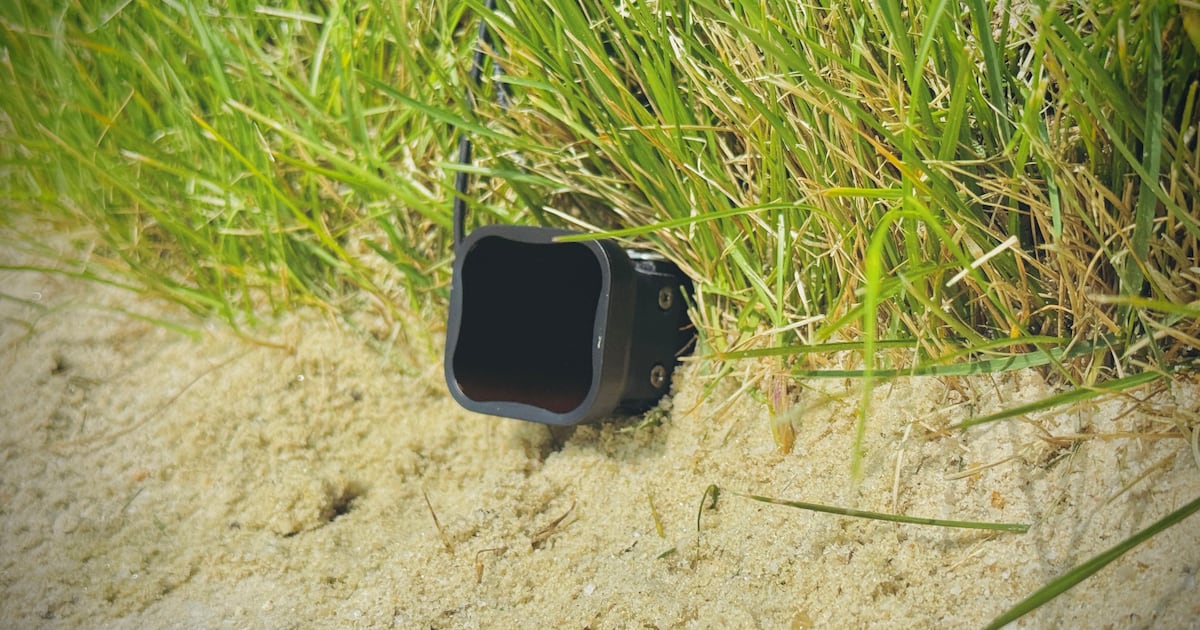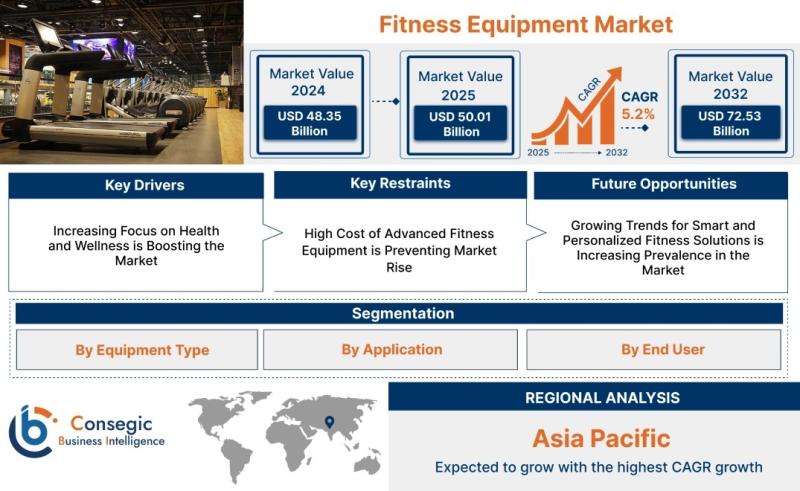
fitness equipment market
“
The global Fitness Equipment Market is experiencing significant growth, driven by a confluence of factors that are reshaping the landscape of health and wellness. At the heart of this expansion is a growing awareness of the importance of physical fitness for overall health and well-being. This awareness is fueled by public health campaigns, rising rates of chronic diseases linked to sedentary lifestyles, and an increasing focus on preventative healthcare. Technological advancements are also playing a pivotal role, with the introduction of smart fitness equipment, wearable devices, and interactive training platforms that enhance the user experience and provide personalized feedback. The integration of features like heart rate monitoring, virtual reality workouts, and data-driven progress tracking are attracting a wider audience, including tech-savvy consumers who are looking for innovative ways to stay active. Furthermore, the fitness equipment market is increasingly addressing global challenges related to public health and accessibility. By providing convenient and effective tools for exercise, it empowers individuals to take control of their health and reduce their risk of developing conditions such as obesity, diabetes, and cardiovascular disease. Moreover, the market is responding to the needs of diverse populations by offering a range of equipment options for different fitness levels, age groups, and physical abilities. This includes inclusive designs that cater to individuals with disabilities, as well as specialized equipment for rehabilitation and therapeutic purposes. The fitness equipment market is not only about selling products but also about promoting a culture of health and wellness that benefits society as a whole.
Get the full PDF sample copy of the report: (TOC, Tables and figures, and Graphs) https://www.consegicbusinessintelligence.com/request-sample/2428
Market Size:
The Fitness Equipment Market is estimated to reach over USD 72.53 Billion by 2032 from a value of USD 48.35 Billion in 2024. It is projected to grow by USD 50.01 Billion in 2025, exhibiting a CAGR of 5.2% from 2025 to 2032.
Definition of Market:
The Fitness Equipment Market encompasses the production, distribution, and sale of a wide range of devices and technologies designed to facilitate physical exercise and improve physical fitness. It includes both equipment for cardiovascular training and strength training, as well as body composition analyzers and other related tools. Key components of this market are:
Cardiovascular Training Equipment: This includes treadmills, elliptical trainers, stationary bikes, rowing machines, and stair climbers. These devices are designed to improve cardiovascular health through aerobic exercise.
Strength Training Equipment: This category includes weight machines, free weights (dumbbells, barbells), resistance bands, and cable machines. These devices are used to build muscle strength and endurance through resistance exercise.
Body Composition Analyzers: These devices measure various body composition parameters, such as body fat percentage, muscle mass, and bone density. They help individuals track their progress and assess their overall fitness level.
Fitness Accessories: This includes fitness trackers, heart rate monitors, smartwatches, and other wearable devices that monitor physical activity and provide data on exercise performance.
Digital Platforms and Apps: Many fitness equipment providers offer digital platforms and mobile apps that integrate with their equipment to provide personalized training programs, track progress, and offer virtual coaching.
Key terms related to the fitness equipment market include:
Home Fitness: Refers to the use of fitness equipment in residential settings for personal exercise.
Commercial Fitness: Refers to the use of fitness equipment in gyms, health clubs, hospitals, and corporate wellness centers.
Connected Fitness: The integration of technology into fitness equipment to provide interactive and data-driven workouts.
Wearable Technology: Devices worn on the body that track fitness-related data, such as heart rate, steps taken, and calories burned.
Get Discount On Report @ https://www.consegicbusinessintelligence.com/request-discount/2428
Market Scope and Overview:
The Fitness Equipment Market’s scope is expansive, encompassing a diverse array of technologies, applications, and industries. The market spans a wide range of fitness equipment, from basic home-use items like dumbbells and resistance bands to sophisticated, technologically advanced machines found in commercial gyms and rehabilitation centers. Technologies involved include mechanical engineering for equipment design, electronics for digital displays and control systems, and software development for connected fitness platforms and apps. Applications of fitness equipment are equally varied, ranging from cardiovascular training and strength building to rehabilitation, weight management, and sports performance enhancement. Industries served include individual consumers, health clubs and gyms, hospitals and rehabilitation centers, corporate wellness programs, hotels and resorts, and educational institutions.
The importance of the Fitness Equipment Market extends far beyond its economic value. In the larger context of global trends, it plays a crucial role in addressing public health challenges such as obesity, cardiovascular disease, and diabetes. With rising healthcare costs and an aging global population, preventative health measures are becoming increasingly important. Fitness equipment provides a convenient and accessible way for individuals to engage in regular physical activity, promoting overall health and well-being. Furthermore, the market contributes to the growing awareness of the importance of physical fitness for mental health and stress reduction. As technology continues to advance, the fitness equipment market is poised to play an even greater role in promoting health and wellness on a global scale.
Top Key Players in this Market
Nautilus, Inc. (United States) Life Fitness (United States) Technogym S.p.A. (Italy) Precor Incorporated (United States) Johnson Health Tech Co., Ltd. (Taiwan) ICON Health & Fitness, Inc. (United States) Matrix Fitness (United States) Cybex International (United States) True Fitness Technology, Inc. (United States) Shuhua Sports Co., Ltd. (China)
Market Segmentation:
The Fitness Equipment Market can be segmented as follows:
By Equipment Type: This includes Cardiovascular Training Equipment (treadmills, ellipticals, bikes), Strength Training Equipment (weight machines, free weights), Body Composition Analyzers, and Others (accessories, functional training equipment). Cardiovascular equipment holds a significant share due to its popularity for cardio health and weight management.
By Application: This includes Cardio Training, Strength Training, Rehabilitation, and Weight Management. Cardio training applications drive a substantial portion of the market, given the widespread focus on cardiovascular health.
By End-User: This encompasses Home Users, Health Clubs/Gyms, Hospitals and Rehabilitation Centers, Corporate Offices, and Hotels and Resorts. Health Clubs/Gyms and Home Users are major segments, with increasing emphasis on fitness accessibility at home.
Market Drivers:
Factors driving growth in the Fitness Equipment Market include:
Growing Awareness of Health and Fitness: Increasing awareness of the health benefits of physical activity is driving demand for fitness equipment.
Technological Advancements: The integration of technology into fitness equipment, such as connected fitness platforms and wearable devices, is enhancing the user experience and attracting new customers.
Rising Obesity Rates: The increasing prevalence of obesity is driving demand for weight management solutions, including fitness equipment.
Government Initiatives: Government programs promoting physical activity and healthy lifestyles are supporting market growth.
Increasing Disposable Income: Rising disposable incomes in developing countries are making fitness equipment more affordable and accessible.
Market Key Trends:
Significant market trends in the Fitness Equipment Market include:
Connected Fitness: The growing popularity of connected fitness platforms and equipment is transforming the way people exercise.
Wearable Technology: The integration of wearable technology into fitness routines is providing users with real-time data and personalized feedback.
Home Fitness: The increasing demand for home fitness solutions is driving innovation in compact and versatile equipment.
Virtual Reality (VR) Fitness: VR technology is creating immersive and engaging fitness experiences.
Focus on Personalized Training: Fitness equipment manufacturers are offering personalized training programs and coaching services.
Market Opportunities:
Growth prospects in the Fitness Equipment Market include:
Expansion in Emerging Markets: Opportunities exist to expand into emerging markets with growing populations and increasing disposable incomes.
Development of Innovative Products: There is potential to develop new and innovative fitness equipment that caters to specific needs and preferences.
Strategic Partnerships: Collaborations between fitness equipment manufacturers, technology companies, and healthcare providers can drive innovation and market growth.
Emphasis on Sustainability: Developing sustainable and eco-friendly fitness equipment can attract environmentally conscious consumers.
Market Restraints:
Challenges and barriers in the Fitness Equipment Market include:
High Initial Costs: The high cost of some fitness equipment can be a barrier for some consumers.
Geographic Limitations: Market access can be limited in certain regions due to infrastructure constraints or regulatory hurdles.
Competition from Alternative Fitness Activities: The market faces competition from other fitness activities, such as outdoor sports and group fitness classes.
Market Challenges:
The Fitness Equipment Market faces a complex set of challenges that impact its growth and sustainability. One of the primary challenges is the rapidly evolving technological landscape. The fitness industry is heavily influenced by advancements in areas such as artificial intelligence, virtual reality, and wearable technology. Keeping pace with these changes requires significant investment in research and development, as well as a willingness to adapt business models to incorporate new technologies. Failing to do so can lead to obsolescence and loss of market share.
Another significant challenge is the increasing competition within the market. The fitness equipment industry is highly fragmented, with a large number of players offering a wide range of products and services. This intensifies the pressure on pricing and margins, making it difficult for companies to differentiate themselves and maintain profitability. Furthermore, the rise of budget-friendly fitness options, such as online workout programs and free community fitness initiatives, poses a threat to traditional fitness equipment providers.
Consumer behavior also presents a challenge. The fitness industry is subject to fads and trends, which can quickly change consumer preferences and purchasing patterns. Companies must be able to anticipate and respond to these shifts in order to maintain relevance and appeal. Additionally, many consumers struggle with motivation and adherence to fitness routines, which can lead to abandonment of fitness equipment and a decline in sales. Addressing this challenge requires a focus on creating engaging and personalized fitness experiences that help users stay motivated and achieve their goals.
Supply chain disruptions and economic uncertainties are also major concerns. The fitness equipment market relies on a complex global supply chain for raw materials, components, and manufacturing. Disruptions to this supply chain, such as those caused by trade disputes or natural disasters, can lead to increased costs and delays in production. Economic downturns can also negatively impact consumer spending on non-essential items like fitness equipment, further exacerbating these challenges.
Finally, sustainability and environmental concerns are becoming increasingly important. Consumers are becoming more aware of the environmental impact of their purchasing decisions, and they are demanding more sustainable products and practices. Fitness equipment manufacturers must address these concerns by developing eco-friendly materials, reducing waste, and minimizing their carbon footprint. Failing to do so can damage their reputation and alienate environmentally conscious consumers.
Market Regional Analysis:
The Fitness Equipment Market exhibits varying dynamics across different regions. North America and Europe have traditionally been dominant markets, driven by high disposable incomes, a well-established fitness culture, and a high prevalence of lifestyle diseases. However, the Asia-Pacific region is emerging as a key growth market, fueled by increasing urbanization, rising disposable incomes, and a growing awareness of the importance of health and fitness. China and India, in particular, are experiencing rapid growth in their fitness equipment markets, driven by a large and increasingly health-conscious population. Latin America and the Middle East also offer growth opportunities, although market development may be slower due to economic and political factors.
Each region’s market is influenced by unique factors, such as cultural norms, government policies, and the availability of fitness infrastructure. In some regions, home fitness is more popular, while in others, commercial gyms and health clubs dominate. Regulatory requirements and trade policies can also impact market access and competitiveness. Understanding these regional differences is crucial for companies seeking to expand their presence in the global Fitness Equipment Market.
Frequently Asked Questions:
Q: What is the projected growth rate of the Fitness Equipment Market?
A: The Fitness Equipment Market is projected to grow at a CAGR of 5.2% from 2025 to 2032.
Q: What are the key trends in the Fitness Equipment Market?
A: Key trends include connected fitness, wearable technology, home fitness, virtual reality (VR) fitness, and a focus on personalized training.
Q: What are the most popular Fitness Equipment types?
A: Cardiovascular Training Equipment and Strength Training Equipment are the most popular types.
Follow us on:
https://www.linkedin.com/company/insight-masters/
https://www.linkedin.com/company/nextwave-research43/
https://www.linkedin.com/company/marketdelta-insights/
https://www.linkedin.com/company/marketdecode32/
https://www.linkedin.com/company/smartmarket-signals/“
Contact Us:
Consegic Business intelligence Pvt Ltd
Baner Road, Baner, Pune, Maharashtra – 411045
(US) (505) 715-4344
info@consegicbusinessintelligence.com
sales@consegicbusinessintelligence.com
Web – https://www.consegicbusinessintelligence.com/
About Us:
Consegic Business Intelligence is a data measurement and analytics service provider that gives the most exhaustive and reliable analysis available of global consumers and markets. Our research and competitive landscape allow organizations to record competing evolutions and apply strategies accordingly to set up a rewarding benchmark in the market. We are an intellectual team of experts working together with the winning inspirations to create and validate actionable insights that ensure business growth and profitable outcomes.
We provide an exact data interpretation and sources to help clients around the world understand current market scenarios and how to best act on these learnings. Our team provides on-the-ground data analysis, Portfolio Expansion, Quantitative and qualitative analysis, Telephone Surveys, Online Surveys, and Ethnographic studies. Moreover, our research reports provide market entry plans, market feasibility and opportunities, economic models, analysis, and an advanced plan of action with consulting solutions. Our consumerization gives all-inclusive end-to-end customer insights for agile, smarter, and better decisions to help business expansion.
Connect with us on:
LinkedIn – https://www.linkedin.com/company/consegic-business-intelligence/
YouTube – https://www.youtube.com/@ConsegicBusinessIntelligence22
Facebook – https://www.facebook.com/profile.php?id=61575657487319
X – https://x.com/Consegic_BI
Instagram – https://www.instagram.com/cbi._insights/
This release was published on openPR.






















 (via @superginger69/TT)
(via @superginger69/TT)








































